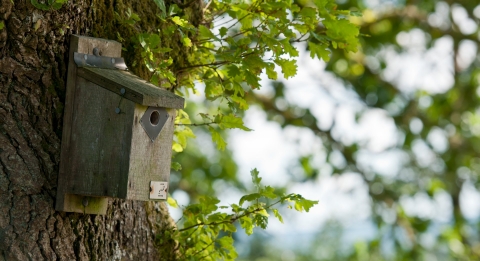
Bird box - credit Ross Hoddinott/2020VISION

Bird box - credit Ross Hoddinott/2020VISION
One sign of spring is when you see birds that are clearly spending time together as a pair.
They feed together; you may even spot what’s called “courtship feeding”, where the male gives food to the female rather than eating it himself. This is probably showing what a good forager he will be when it comes to providing for nestlings, though I do wonder how good a signal it is when both of them are sitting on the same feeder and the male is simply passing sunflower seeds to his mate!
A little later you may see them investigating possible nest sites. Look out for pairs of house sparrows around roofs and gutters; Blue tits and Great tits checking nest boxes, or even removing old nest material; Nuthatches investigating holes in trees; if you are really lucky, House martins, Swallows and Swifts – back from their African wintering-grounds – looking for nesting opportunities in our buildings. Birds carrying moss, grass, feathers or twigs is a good sign that they have started to build.
Once egg-laying starts, you are more likely to see birds feeding on their own, as males and females need to eat different things: females need calcium to form eggshells. I often notice small birds pecking around our neighbours' chicken run: those may well have found an easy source of calcium in the grit that's left out for the hens.
Once the clutch of eggs is complete, you’ll rarely see the pair together, as one or other bird will be sitting on the nest keeping the eggs warm. There may seem to be fewer birds around, and you may notice that there are more males than females, as males often do more foraging and less incubating.
When the eggs hatch, the rate at which the adults collect food increases dramatically, as they may have up to a dozen (or more, in Blue tits) hungry beaks to feed. Adults carrying food is a near-certain sign that they have nestlings: birds normally eat food as soon as they are in a safe place, though a few, such as nuthatches, will store food in caches throughout the year. Adults may look increasingly scruffy at this stage: the effect of spending time sitting on a cramped nest, and simply not having time to preen their feathers back to good condition.
After fledglings leave the nest, most spend time with their parents learning how to feed themselves, though this may only last a few days. Young birds often have distinctive plumage, usually less obvious (juvenile Robins are spotty, with no red breast) to protect them until they learn how to detect and avoid predators. Some species, such as Long-tailed tits and Chiffchaffs, stay in large family groups.
In late summer, there’s often an abrupt drop in the number of birds we see, particularly in gardens. That’s because the adults (and some juveniles, too) will take the opportunity to replace their worn feathers. This moulting takes a lot of energy and reduces the bird’s ability to fly, so they do it in places where they can find food without coming into the open where they are at greater risk from predators. Some may still be in gardens, but they will be in hedges and bushes, and not drawing attention to themselves.
Autumn and winter see the greatest variation in behaviour, often depending on whether a species’ food and other requirements are evenly spread or patchy. Evenly-spread food usually results in birds spending the winter apart: if food is available in clumps then they are more likely to gather in flocks to look for it, knowing there will be plenty to go around. Birds such as Blue tits spend this time in large, loose flocks: we once had over a hundred birds fly over the garden in a steady stream. Starlings, famously, roost together in groups that can reach thousands or millions and fly together in great aerial displays called murmurations. That’s definitely something to look forward to seeing again.
You can feed the birds and support the work of Gwent Wildlife Trust in one fell swoop by buying Vine House Farm bird food as every purchase of bird food raises money for the Trust.